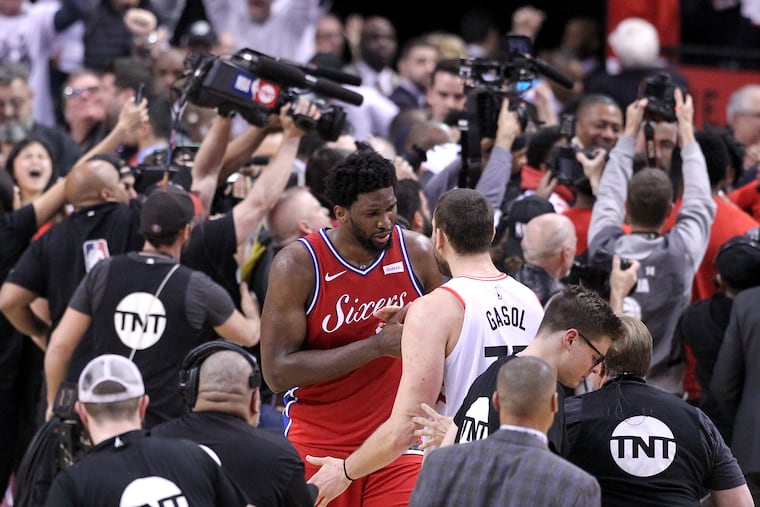The Sixers drafted Joel Embiid five years ago. Think about what’s happened since, and what’s ahead. | Mike Sielski
Think about how far Joel Embiid has come, and how far he might yet go if he really does turn his heartbreak over that playoff loss into fuel for his future.

The 76ers drafted Joel Embiid five years ago. Consider how the conversation around him, the concerns about him, have evolved over that time.
He had broken a bone in his foot just before that 2014 draft, which scared off two teams and allowed the Sixers to select him with the No. 3 pick. And so it began: When would he play for the Sixers? Would he ever play for the Sixers? He was gulping down Shirley Temples. He was pitching fits. He was adjusting to life as an NBA player while he was unable to play in the NBA. He re-broke the foot. Should they have played it safe, traded down in that draft and acquired a player or players who could have helped the franchise’s rebuild right away? His younger brother, Arthur, died. Joel Embiid had begun playing basketball just when he was 16. He still had not played a game yet for the Sixers.
He finally suited up. He played wonderfully, but in just 31 games. He tore the meniscus in his left knee in 2017. He came back and played wonderfully again. The statistics he compiled were comparable to Wilt Chamberlain’s. Markelle Fultz crashed into him and broke Embiid’s face. He returned from that, too. The Sixers won a playoff series, then lost to the Celtics. Al Horford drove him batty, shut him down. He came back again and played wonderfully again … when he played. There was knee soreness. There was gastroenteritis. There were natural questions about what kind of physical shape he was in. Kawhi Leonard hit an incredible, and incredibly fortunate, shot in a Game 7. And Joel Embiid cried.
That was the last and lasting image of Embiid from that Eastern Conference semifinal series against the Toronto Raptors: his face flooded with tears, his upper body wrapped in a consoling hug from the Raptors’ Marc Gasol. If you’re looking for a moment to mark the next step in Embiid’s career, to signify the new phase that he has to enter to fulfill his and the Sixers’ potential, you could do worse than that emotional reaction to a crushing loss. It was an indication of just how much that game had mattered to him, and the key for him and the Sixers now is simple: The desire to avoid feeling that disappointment again has to inform every aspect of his basketball life, and he has reached the point in his career when he should be ready and open to developing into a more diligent, committed superstar.
That’s been the frequent and easy criticism of Embiid since the Sixers drafted him. The weight gain, the fondness for sugar in his diet, those viral moments when he danced on stage during a concert or dunked on some poor civilian during a pickup game: What was his higher priority, becoming great or just having fun? In a way, merely asking the question at that point in Embiid’s life may have been asking too much of him. Consider another timeline, before he joined the Sixers:
He left Cameroon at age 16. He was at Monteverde Academy in Florida for less than a year. He went to The Rock Christian School, also in Florida, for less than a year. He went to the University of Kansas for less than a year. Then an NBA team drafted him, allowing him to make millions of dollars, affording him a measure of freedom and wealth that was once just the stuff of his dreams. If you had been in his (extremely large) shoes, how would you have handled or reacted to such shifts and opportunities in your life at so young an age, when everything seemed seismic in its effect?
Regardless of Embiid’s condition when the Sixers drafted him, whether he was hobbled or healthy, it was always going to take him time to gain the experience and the wisdom required to become the player he can be, the player people around here want and expect him to be. Part of that process was tied to the circumstances intrinsic to his journey here, but part of it was just the maturation that every young, elite athlete must undergo. Now that Embiid is 25, you’re starting to see the shift in the discussion around and about him, and it makes those previous worries from years ago feel even deeper in the past. Could Embiid suffer another severe injury? Of course. But that fear, generally speaking, has been supplanted by other, subtler questions. In the modern NBA, can the Sixers built a championship team around a post player, even one as gifted as Embiid? Will he and Ben Simmons reach their full potential together? Was Horford really the ideal power forward to pair with him?
We’re talking floor spacing now, which presumes Embiid will be on the floor, which everyone does now. Think about that. Think about how far he’s come, and how far he might yet go if he really does turn his heartbreak over that playoff loss into fuel for his future.
“Overall the risk isn’t in taking him, to me,” ESPN analyst and former NBA coach Jeff Van Gundy said in a 2014 interview. “The risk would have been in not taking him. If you have a chance for a Hall of Fame-caliber player, you take it, and then you hope for the best. You don’t win championships without Hall of Fame-caliber players. Here’s my thing: Even if you knew this going in, would you take seven years of greatness or 12 years of mediocrity? It’s not just longevity. It’s also, how great can you be?”
Five years later, it remains a question that Joel Embiid has only begun to answer.